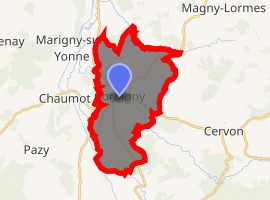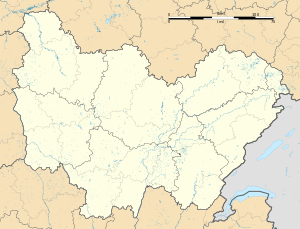Corbigny
Corbigny is a commune in the Nièvre department in central France. The city is located next to the Morvan and is one of the five Cities-Doors of Parc naturel régional du Morvan.
Corbigny | |
|---|---|
The Anguison river in Corbigny | |
 Coat of arms | |
Location of Corbigny 
| |
 Corbigny  Corbigny | |
| Coordinates: 47°15′27″N 3°41′03″E | |
| Country | France |
| Region | Bourgogne-Franche-Comté |
| Department | Nièvre |
| Arrondissement | Clamecy |
| Canton | Corbigny |
| Intercommunality | Pays Corbigeois |
| Government | |
| • Mayor (2001–2008) | Jean-Paul Magnon |
| Area 1 | 20.06 km2 (7.75 sq mi) |
| Population (2017-01-01)[1] | 1,482 |
| • Density | 74/km2 (190/sq mi) |
| Time zone | UTC+01:00 (CET) |
| • Summer (DST) | UTC+02:00 (CEST) |
| INSEE/Postal code | 58083 /58800 |
| Elevation | 182–275 m (597–902 ft) |
| 1 French Land Register data, which excludes lakes, ponds, glaciers > 1 km2 (0.386 sq mi or 247 acres) and river estuaries. | |
History
The city used to be one of the first steps for pilgrims starting from Vézelay on the road to Santiago de Compostela.
On 15 January 1934, a Dewoitine tri-motor commercial airliner, the 'Emeraude' (Emerald), returning from Indochina, crashed into a hillside near Corbigny, killing all ten people aboard, including the director of Air France, Maurice Noguès, and the governor-general of the colony of French Indochina, Pierre Pasquier.[2]
Monuments
The Saint Léonard Abbaye which was built in the 18th century is one of the city's most famous attractions. A festival of classical music takes place in this Abbaye every summer.
Demographics
At the 1999 census, the population was 1709. On 1 January 2006, the estimate was 1681. The residents of Corbigny are known as 'Corbigeois.'
See also
References
- "Populations légales 2017". INSEE. Retrieved 6 January 2020.
- A photograph of the memorial to those killed in the crash of the "Emeraude" on 15 January 1934 can be seen here.